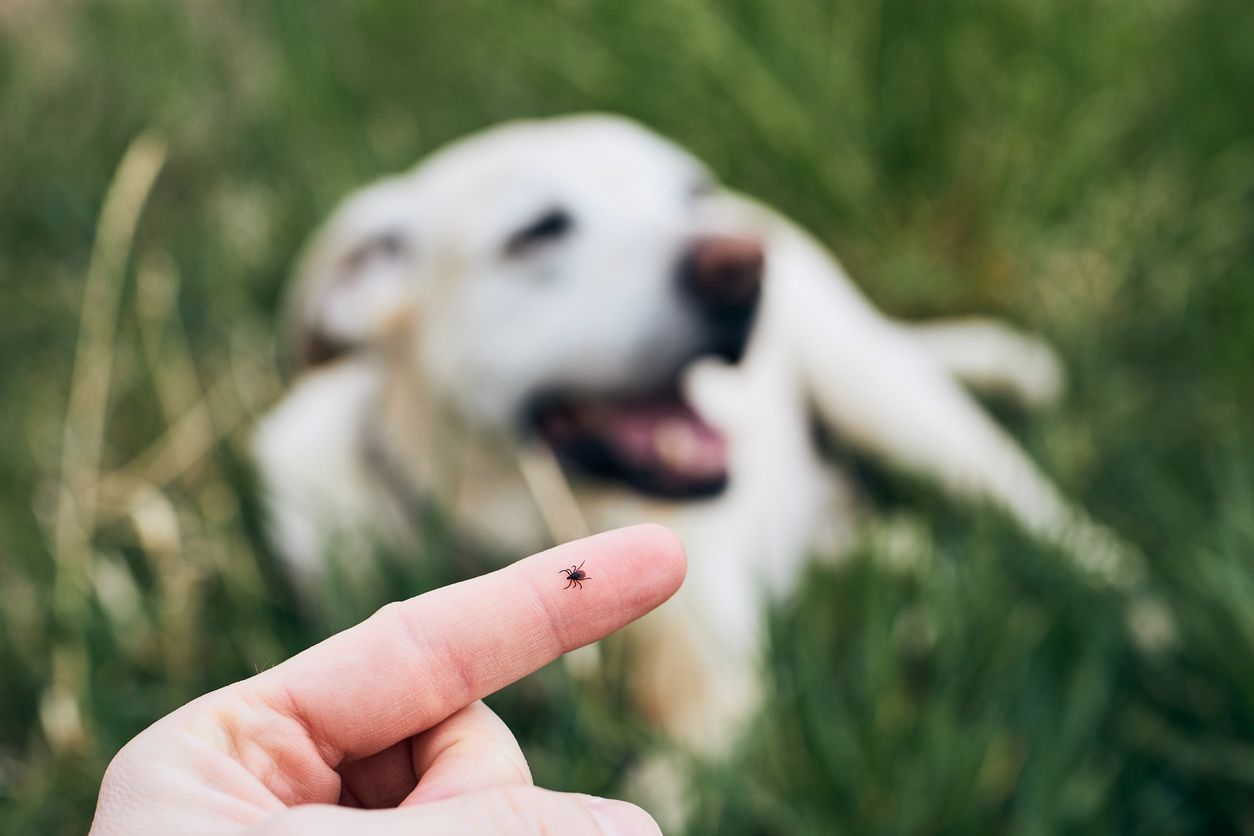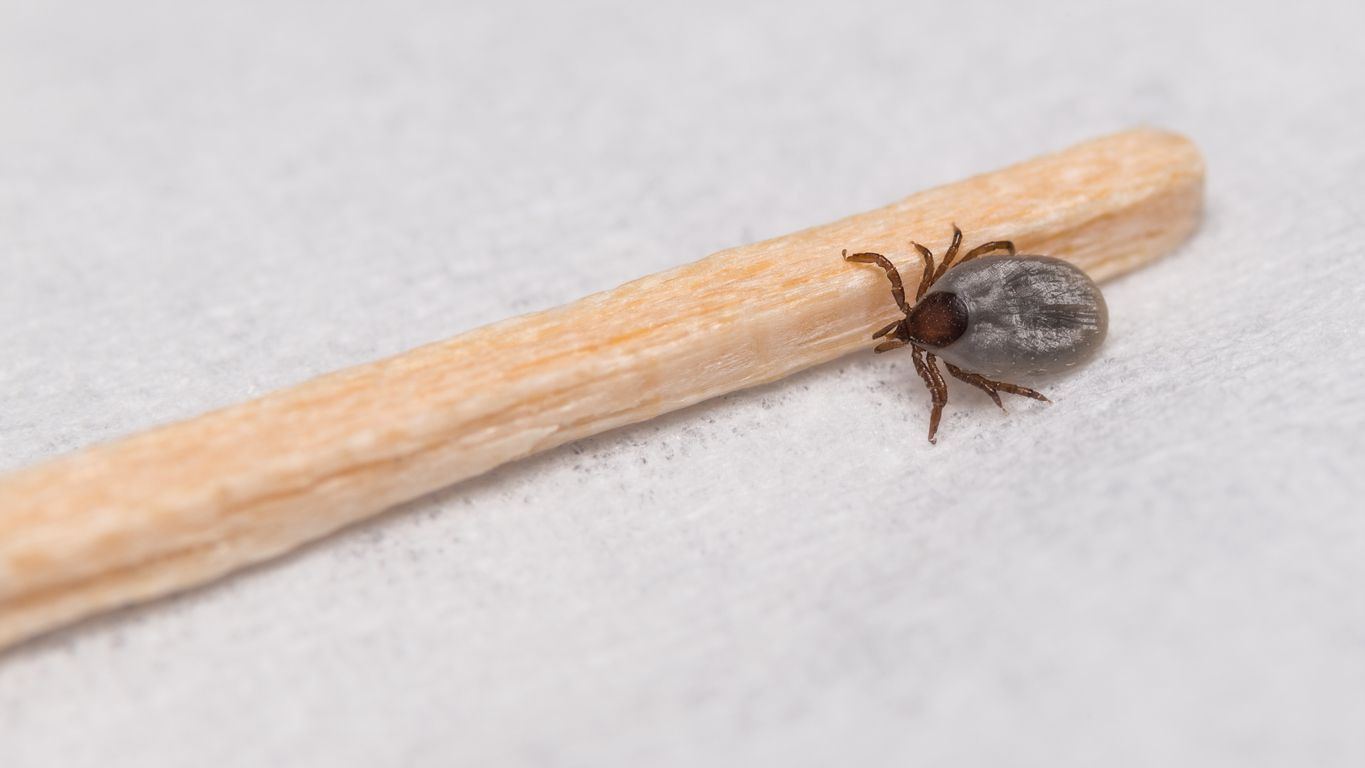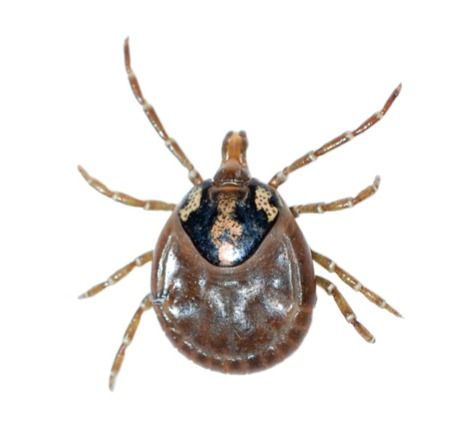Ticks: Life cycle, species, and where you’re most at risk

Finding a tick on your pet can be alarming, but knowing as much as possible about these pests can help you protect your pet from tick bites, tick-borne illnesses, and other health complications. Many species of ticks are found in North America, varying in size, color, and location. Some species of ticks can transmit illnesses, such as Lyme disease and Rocky Mountain spotted fever. All ticks found on a pet should be removed promptly and safely. Keeping your pets on year-round veterinarian-recommended tick prevention is the best way to reduce the risk of serious tick-borne illness. To help you protect your pets, we’ll cover:
- What ticks and tick bites look like
- How ticks attach to pets and how to remove them
- Which tick species live in North America and where they’re found
- The medical risks posed by ticks
Though there are more than 80 species of ticks in North America, only a few are medically important to pets, such as the deer or black-legged tick, American dog tick, Rocky Mountain wood tick, brown dog tick, Gulf Coast tick, and the lone star tick. Each of these tick species inhabits a different geographical area of North America and is associated with the spread of different diseases. Some of these diseases can be severe or even life-threatening, making year-round tick prevention important for all at-risk pets. You can talk virtually to a veterinary professional to learn more about your pet’s risk for tick bites and get a recommendation for a tick preventative that’s safe and effective for your unique situation.
Along with using tick prevention, it’s important to perform tick checks after being in areas where ticks are known to inhabit, and any ticks found should be removed promptly and safely. This adds another layer of protection against disease transmission and other tick-related health concerns.
What ticks and tick bites look like
Ticks are small arachnids that bite and attach to animals and humans to feed on blood. An attached tick usually looks like a small, dark bump on the surface of the skin, similar to a mole. Ticks can vary widely in size and color depending on the tick’s species, age, and how long they’ve been attached and feeding on their host.
Ticks are usually flat, dark, and about the size of a sesame seed (1–3 mm) when they first attach. As they feed over several days and become engorged with blood, they become larger and rounder, giving the appearance of a small bean (approximately 10 mm) anchored to the skin at one end. An engorged tick’s belly has a slightly gray appearance.
Ticks attach to their host by firmly inserting their mouthparts into the skin while their legs and bodies stay on the outside. The legs may be very small, difficult to see, and easily overlooked. The tick’s mouth is what anchors it to the skin, leaving the rest of the body extending outward from that single point of attachment. They can stay attached despite a dog self-grooming, being brushed by their owner, or getting a bath.
After a tick falls off or is removed, the bite usually looks like a red, crusty, inflamed sore. There is often a black spot in the center of the bite wound where the mouthparts were attached. This is often mistaken as the head being left behind, a common myth about tick bites. Tick bites often take one to two weeks to heal, even if the tick did not transmit disease or cause a skin infection.
The tick life cycle
By learning how ticks find and use their hosts to develop, you’ll be able to recognize what ticks look like at different stages as well as have a better understanding of when your pet is most at risk and how tick-control products can be used most effectively. A tick’s appearance changes throughout its life cycle, so knowing what to look for can help you more easily identify and remove ticks from your pet.
Most ticks go through four life stages:
-
Tick egg

-
Six-legged larvae

-
Eight-legged nymph

-
Adult tick

The entire tick life cycle usually takes two to three years to complete, though some species, like the brown dog tick, may reproduce more quickly indoors. The exact duration of a tick’s life cycle varies depending on the species of tick and the environmental conditions.
Eggs typically hatch into larvae in the early spring or summer. Larvae quest for their first host and spend a few days feeding before dropping off to molt into nymphs, usually in the fall. Nymphs may remain dormant through the winter and seek a new host the following spring or summer. After feeding for several days, nymphs drop off their host and molt into adults.
Adults typically appear later in the summer or fall, more than a year after the eggs were laid. Female adults that feed and mate successfully lay thousands of eggs the next spring. The full life cycle of many tick species takes about two years, although it can be shorter or longer depending on the species and environmental conditions.
How pets get ticks
Since ticks don’t move far on their own, most pets pick up ticks by being outdoors in tick habitat. Ticks live in tall grass, leaf litter, brushy areas, and areas frequented by wildlife. Wild animals such as deer, rodents, and raccoons are common hosts for ticks and help maintain tick populations.
When a tick is ready to feed and begins questing, it stands on grass or brush with its front legs outstretched, waiting for a host to grab onto. Ticks do not fly, jump, or drop from trees onto their hosts.
Once a tick grabs onto a new host, it crawls to a preferred spot on the body and latches on with its mouth. Ticks usually stay attached to a single host until they’re done eating or are dislodged. Although uncommon, it’s possible for a pet to pick up a tick that was brought indoors by another pet or person if the tick is dislodged before it’s done eating, which is how pets that do not go outdoors can get ticks.
How to perform a tick check on your pet
It’s important to perform regular checks on pets that may have been exposed to ticks, even if the pet is on tick prevention. Most tick preventatives do not repel ticks. Instead, they work by killing ticks quickly after they have bitten their host and taken a blood meal. For this reason, it’s common to occasionally find ticks on a pet receiving regular tick prevention. This doesn’t mean the tick prevention you’re using isn’t working. If you’re concerned, talk to a vet to ensure the tick product you’re using is effective and that you’re using it correctly.
To perform a tick check, run your fingers over your pet’s body close to the skin and through their hair to feel for abnormal bumps. Some ticks are very small, especially if they haven’t been feeding long, and are more easily felt than seen. It can be especially difficult to see ticks on pets with thick fur or dark skin or hair. Check the entire body, including between the toes, under harnesses and collars, in the ears, and around the anus.
How to remove a tick
To remove an attached tick from your pet, grasp it tightly at the surface of the skin with a clean pair of fine-point tweezers or a tick removal tool. “Getting as close to the skin surface as possible is important because you don’t want to squeeze the tick’s body; if you squish its abdomen, this may push its gut contents back through the mouth, injecting them into the skin,” explains Dr. Jo Myers, a veterinarian on the Vetster platform. “This can expose the pet to any pathogens or infectious agents that cause tick-borne illness.”
Once you have grasped the tick, gently pull it straight outward until the skin tents. Wait for the tick to release its grasp on the skin. Once removed, dispose of the tick by dropping it into rubbing alcohol, flushing it down a toilet, or wrapping it tightly with tape. Always wear gloves when removing a tick from your pet and wash your hands after disposing of the tick. Clean the bite area on your pet’s skin with soap and water.
Using a pair of fine-point tweezers is the best method to remove a tick. Avoid other methods such as a lit match, petroleum jelly, nail polish remover, or other home remedies. These methods often cause additional skin damage and may cause the tick to regurgitate its stomach contents into the bite wound, increasing the risk of disease transmission.
US tick species and where they’re most active
There are more than 90 species of ticks in North America and more than 850 worldwide. The species of ticks that most commonly affect pets in the US vary in appearance and geographical distribution.
The deer tick, or black-legged tick (Ixodes species) is found primarily in the northeastern, mid-Atlantic, southeastern, and north-central regions of the United States. The American dog tick and Rocky Mountain wood tick (Dermacentor species) are located primarily in and east of the Rocky Mountains and some areas of the Pacific Northwest. The brown dog tick (Rhipicephalus sanguineus) is very common and found throughout the United States and all over the world. This species is unique due to its ability to infest homes and other indoor spaces. Finally, the Gulf Coast and lone star ticks (Amblyomma species) are found in the southeastern, south-central, eastern, and midwestern regions of the United States.
The geographical ranges of various tick species are growing, in large part due to climate change. Seasonal activity varies between species but typically spikes in early spring and late fall when populations increase. Though early spring and late fall are considered peak “tick season,” ticks can still be active in the winter and other months throughout the year, making year-round tick prevention important for all pets.
Risk of tick-borne illnesses
Most tick bites cause only minor, temporary skin irritation that heals on its own. However, there are risks associated with tick bites. Ticks can carry disease-causing organisms that may lead to severe or even life-threatening illness. For many tick-borne diseases, the tick must remain attached and feeding for 12–24 hours before transmission occurs, though some pathogens may be transmitted sooner.
In addition to potentially transmitting disease, ticks can also cause health problems simply through the act of biting and feeding. Tick bites open the skin and can become infected, and heavy tick infestations may cause so much blood loss that the host becomes anemic.
Tick-borne diseases that can affect pets include:
- Lyme disease
- Ehrlichiosis
- Anaplasmosis
- Rocky Mountain spotted fever
- Babesiosis (piroplasmosis)
- Hepatozoonosis
- Tick paralysis
Tick-borne illnesses are more commonly reported in dogs than in horses or cats. Since these diseases can be severe or life-threatening, it’s important to use vet-recommended preventative strategies to minimize your pet’s risk. The use of year-round, vet-recommended tick prevention helps protect your pet. There is also a Lyme disease vaccine available for dogs. Talk to a veterinarian to determine your dog’s risk for Lyme disease and if they may benefit from receiving the vaccination. An appointment with an online vet is a great way to get a recommendation for a safe and effective tick preventative based on your pet’s species, size, health history, and overall risk.
FAQ - Everything pet owners need to know about ticks
Which US states have the most ticks?
Ticks are found all over the United States, but populations are highest in the northeastern and Midwest states east of the Rocky Mountains. California also has high tick populations. Talk to a veterinarian about your dog’s risk for ticks and tick-borne diseases and how best to prevent them.
Where do ticks live?
Ticks live in tall grass, leaf litter, brushy areas, and areas frequented by wildlife, such as deer, rodents, and raccoons. Pets pick up ticks by walking through these areas and coming into contact with ticks that are waiting for a host, a behavior known as “questing.” Ticks do not fly, jump, or fall from trees and do not travel far on their own.
How likely is a dog to get sick from a tick bite?
Most tick bites do not lead to illness. In fact, only a fraction of ticks are carrying disease-causing organisms, and even when a dog is bitten by an infected tick, the chance of the dog getting sick is relatively low. Ticks in some geographical areas are more likely to carry disease-causing organisms than others, so disease risk varies depending on where you live. While the risk may be lower in certain areas, it is never completely absent. Tick-borne illnesses can be severe and even life-threatening, making tick prevention important for all dogs.
Disclaimer: This article, its content, and its related references do not constitute veterinary advice and should not be considered a substitute for veterinary care. If your pet is showing any symptoms that could indicate a medical emergency, please seek immediate emergency care.




